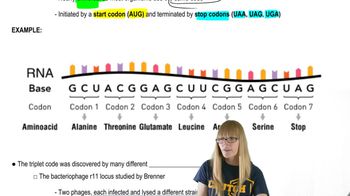Here are the essential concepts you must grasp in order to answer the question correctly.
tRNA and Anticodons
Transfer RNA (tRNA) molecules are essential for translating the genetic code into proteins. Each tRNA has an anticodon that is complementary to a specific codon on mRNA. The sequence of the anticodon determines which amino acid the tRNA carries, allowing for the correct incorporation of amino acids during protein synthesis.
Recommended video:
Codons and Amino Acids
Codons are sequences of three nucleotides on mRNA that specify a particular amino acid. The genetic code is universal, meaning that each codon corresponds to the same amino acid across different organisms. Understanding the relationship between codons and their corresponding amino acids is crucial for interpreting genetic information and protein synthesis.
Recommended video:
DNA Coding Strand and Polarity
The DNA coding strand is the strand of DNA that has the same sequence as the mRNA (except for thymine being replaced by uracil). It runs in a 5' to 3' direction, which is important for transcription and translation processes. The polarity of nucleic acids (5' to 3' direction) is fundamental for understanding how genetic information is read and synthesized.
Recommended video:
 Verified step by step guidance
Verified step by step guidance Verified video answer for a similar problem:
Verified video answer for a similar problem: